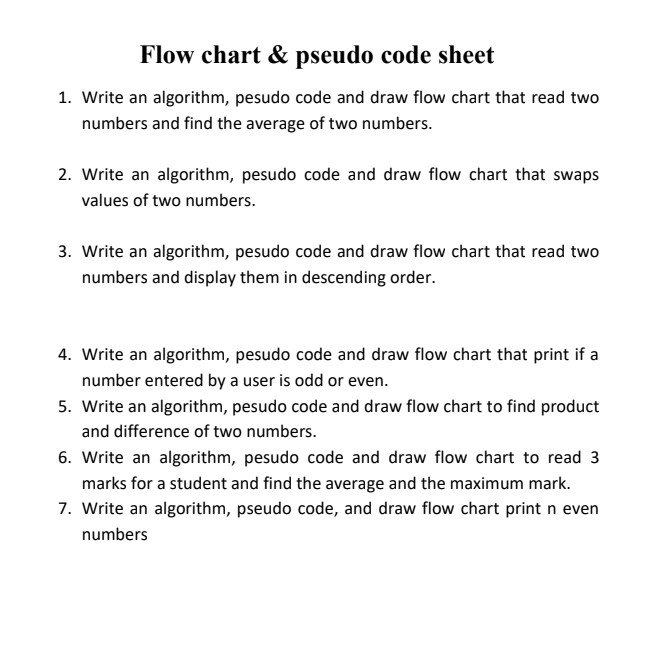Write an algorithm, pseudo code and draw flow chart that read two numbers and find the average of two numbers. Write an algorithm, pseudo code and draw flow chart that swaps values... Write an algorithm, pseudo code and draw flow chart that read two numbers and find the average of two numbers. Write an algorithm, pseudo code and draw flow chart that swaps values of two numbers. Write an algorithm, pseudo code and draw flow chart that read two numbers and display them in descending order. Write an algorithm, pseudo code and draw flow chart that print if a number entered by a user is odd or even. Write an algorithm, pseudo code and draw flow chart to find product and difference of two numbers. Write an algorithm, pseudo code and draw flow chart to read 3 marks for a student and find the average and the maximum mark. Write an algorithm, pseudo code, and draw flow chart print n even numbers.

Understand the Problem
The question is asking for the creation of algorithms, pseudo codes, and flow charts for various programming tasks, such as calculating averages, swapping values, ordering numbers, and categorizing inputs. These tasks are intended for educational purposes in computer science.
Answer
- Average: $ \text{average} = \frac{num1 + num2}{2} $ - Swap values: Use a temporary variable. - Descending order: Compare and print accordingly. - Odd/Even check: $num \mod 2$. - Product: $ \text{product} = num1 \times num2 $; Difference: $ \text{difference} = num1 - num2 $. - Average of marks: $ \text{average} = \frac{mark1 + mark2 + mark3}{3} $. - Print even numbers up to `n`.
Answer for screen readers
-
Average of two numbers: $$ \text{average} = \frac{num1 + num2}{2} $$
-
Swap values using a temporary variable.
-
Display numbers in descending order: If $num1 > num2$ then print $num1, num2$ else print $num2, num1$.
-
Odd or Even: $num \mod 2 == 0$ (even), else (odd).
-
Product: $$ \text{product} = num1 \times num2 $$ Difference: $$ \text{difference} = num1 - num2 $$
-
Average marks: $$ \text{average} = \frac{mark1 + mark2 + mark3}{3} $$
-
Print even numbers up to
n.
Steps to Solve
- Calculating the Average of Two Numbers
Begin by reading two numbers, let's say num1 and num2. The average can be found using the formula:
$$ average = \frac{num1 + num2}{2} $$
- Swapping Values of Two Numbers
To swap values, use a temporary variable:
- Store
num1intemp. - Assign
num2tonum1. - Assign
temptonum2.
- Sorting Two Numbers in Descending Order
Read two numbers, num1 and num2. Compare them and then display them in descending order:
- If
num1 > num2, printnum1followed bynum2. - Otherwise, print
num2followed bynum1.
- Checking Odd or Even
Read a number, num. Check if it is odd or even by using:
- If
num \mod 2 == 0, it is even; otherwise, it is odd.
- Finding Product and Difference of Two Numbers
Read num1 and num2. Calculate:
- Product as $ \text{product} = num1 \times num2 $.
- Difference as $ \text{difference} = num1 - num2 $.
- Calculating Average and Maximum Marks of a Student
Read three marks: mark1, mark2, and mark3. For average:
$$ average = \frac{mark1 + mark2 + mark3}{3} $$
For maximum, compare the marks and store the highest value.
- Printing Even Numbers
Read a number n. Use a loop to print all even numbers up to n:
- For
ifrom 0 ton, check ifi \mod 2 == 0. If true, printi.
-
Average of two numbers: $$ \text{average} = \frac{num1 + num2}{2} $$
-
Swap values using a temporary variable.
-
Display numbers in descending order: If $num1 > num2$ then print $num1, num2$ else print $num2, num1$.
-
Odd or Even: $num \mod 2 == 0$ (even), else (odd).
-
Product: $$ \text{product} = num1 \times num2 $$ Difference: $$ \text{difference} = num1 - num2 $$
-
Average marks: $$ \text{average} = \frac{mark1 + mark2 + mark3}{3} $$
-
Print even numbers up to
n.
More Information
These algorithms help in understanding basic programming constructs including conditional statements, loops, and arithmetic operations. They are essential for beginners in computer science to grasp fundamental programming concepts.
Tips
- Forgetting to initialize variables: Always ensure variables are initialized before use.
- Using incorrect logic in comparisons: Be careful with the comparison operators.
- Not handling user input correctly: Validate user inputs to avoid runtime errors.
AI-generated content may contain errors. Please verify critical information